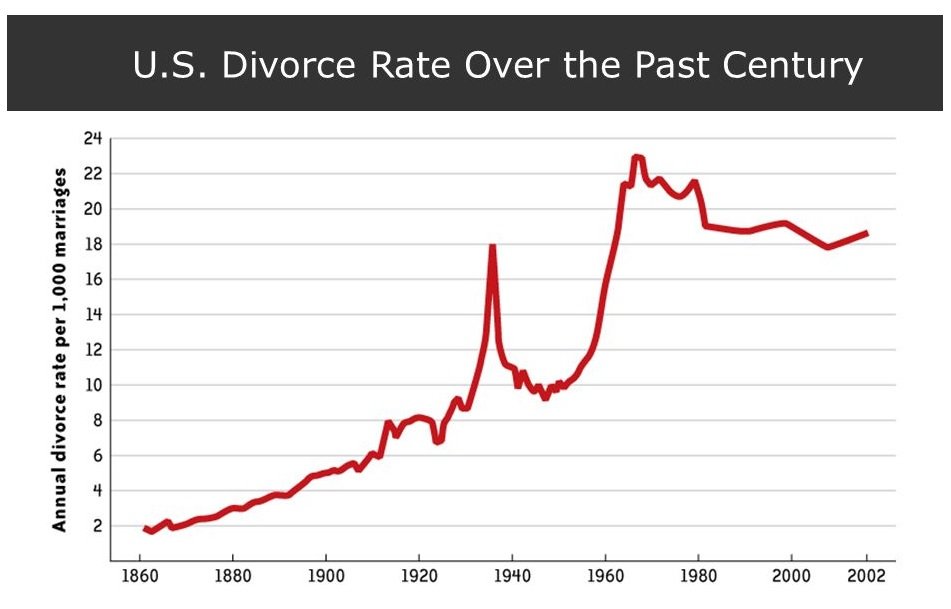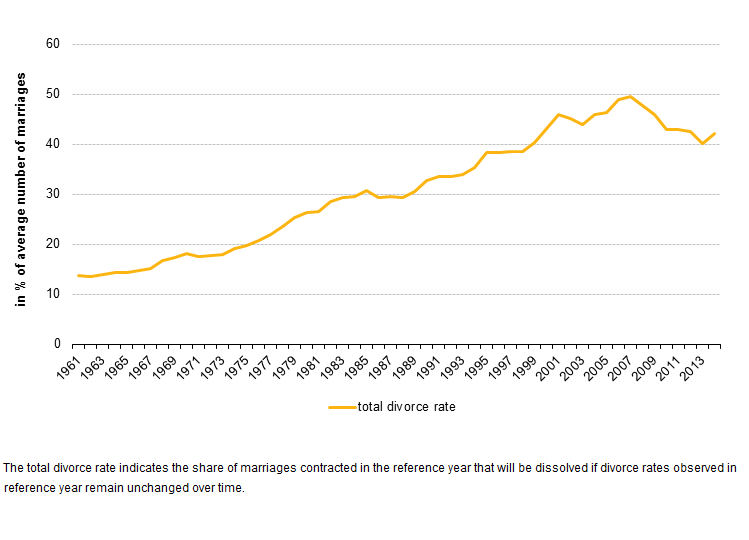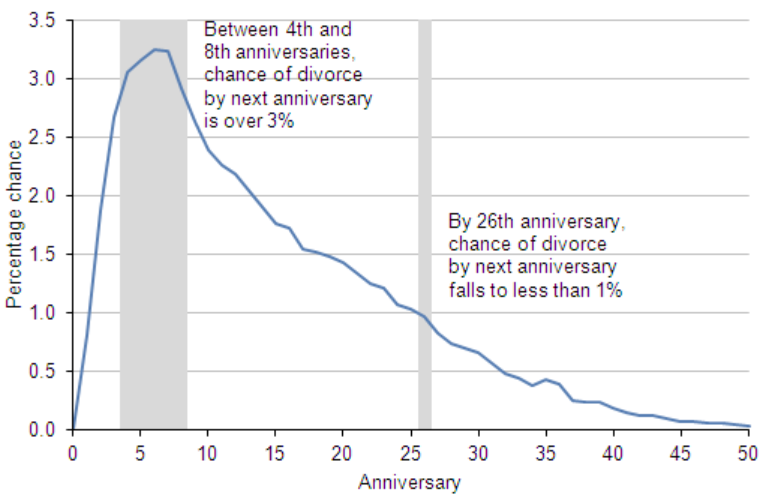Investigating the Causes and Risks for Divorce
- October 17, 2018
- divorce
- Posted by admin
- Leave your thoughts
No secret has been made in mass media or public circles of the skyrocketing rate of divorce across the western world in the latter part of the 20th century. “50% of marriages end in divorce” may be the most widely quoted (and misquoted) statistic in all of the public discourse we hear. But there must be more to divorce than mere headlines can reveal. This article investigates divorce in a more nuanced and analytical fashion to reveal interesting facts that may offer clues in our attempts to understand the future trajectory of divorce and devise measures to reverse the increases.
The advantages at an individual and societal level are abundantly clear and there is a true consensus across political parties that we must do more to help keep marriages from falling apart. However, the proposed strategies for achieving this are as disparate as the voices from which they emerge. By examining the historical data behind divorce we hope to shed light on what factors may decrease (or indeed increase) divorce in the future. Learning from this wealth of information is our best tool in the fight against broken families.
1. After a sustained period of increases, divorce is now falling

For a long time, strong religious institutions exerted their influence in many ways that are today alien. Socially conservative, religious communities along with the widespread belief in the sinfulness of divorce meant that separations were extremely uncommon for centuries.
The urbanization and radical upheaval that came with the age of industrialization led to a slow but steady rise in divorce throughout 19th century America. The Great Depression actually led to a brief respite in the trend of growing divorce, albeit for all the wrong reasons.
WWII brought with it a major spike in both marriages and subsequent divorces. It has been hypothesized that young couples may have hastily rushed to exchange vows before deployment only to realize on reuniting that they may not have been ideally matched after all.
Unsurprisingly, the massive popularity of socially liberal ideas in the 1960s brought with it a dramatic uptick in divorce. Record highs continued until around 1980 but have since fallen somewhat.
In 2016, Time reported that the United States divorce rate had reached its lowest level in almost 40 years. Not only is the marriage rate dwindling (with more individuals choosing to remain single or cohabit), but couples also seem to be taking a more cautious route by avoiding early marriage. This is evidenced by the fact that the average age of first marriage has risen dramatically from 20 in 1960 to 27 today.
Individuals appear to be waiting longer to maximize their chances of finding a compatible life partner. Although data seems to vindicate this strategy (couples who marry young are more likely to seek a divorce), the true picture is more complex. The correlation between higher divorce rates and younger age of marriage is not proof of causation. The data is complicated by ethnic and socioeconomic factors that also play into younger marriage. Indeed, a “U-shaped” graph begins to emerge when we study the bigger picture of the age of marriage and divorce, with rates falling up to around the age of 30 then increasing again in late-to-marry couples.
To show that this overall phenomenon is not strictly limited to the United States, here are some more recent data from the European nation of Austria:

2. Most divorces are initiated by the female partner… and the peak time is 7 years in
The Washington Post covered research in 2015 that found that women initiated divorce 69% of the time in heterosexual couples. The younger the age of the individuals at the time of divorce, the more likely that the initiating party was a woman.
It is highly likely that marital instability is influenced in part by the real or imagined availability of alternative suitors. In fact, the Stanford sociologist interviewed for the article cites heightened marital expectations as a key cause of modern relationship instability. Whereas in the past, gender roles were narrowly defined, today women find themselves holding out for a man who can seemingly offer everything all at once.

It is worth remembering that divorce is an irreversible short-term solution to a problem with permanent ramifications for the health and wellbeing of both adults and any children that the couple may have.
In many cases, marital woes can be dealt with and overcome with the help of an experienced marriage counselor. Proper engagement with this kind of talk therapy is known to reduce the chances of divorce substantially. Putting the kids first is of utmost importance but many parents naively believe they can shepherd their children through a breakup without inflicting any serious harm on the child.
As the logic goes, it’s no use staying together for the kids if mom and dad are fighting constantly. However, research suggests that it is the severing of the parental relationship itself that carries the most harmful adverse effects for children. Sticking together, and overcoming tumultuous times, can protect children from a costly divorce that serves as an independent risk factor in all sorts of negative future outcomes for the child. This includes early, unwanted pregnancy, drug abuse, and reduced educational attainment.
If you are suffering abuse at the hands of your partner then it is important to know when to walk away. Marital woes and disagreements can be ironed out with strategic planning and kindness, but abuse should never be tolerated. Knowing the difference between the two is vital to guiding you through your decision-making process.
3. Children of divorced parents are more likely to divorce themselves (breaking the vicious cycle)
This study, like many others before it, reinforces a strong body of evidence showing that the deleterious effects of parental divorce come as a result of the divorce itself, not from witnessing parental conflict. This should serve as a powerful incentive for parents to work through any conflict without resorting to separation.
Daughters of divorced couples seem to be hardest hit when it comes to suffering lasting effects on their confidence in the institution of marriage. At the outset of their marriage, daughters of divorced couples report feeling lower levels of commitment and less confidence in the future of their relationship than women whose parents remained together.
To break the vicious cycle of divorce feeding divorce we need to approach the problem with a simple, yet a challenging solution. That is less impulsivity, greater listening, and more kindness.
4. Marriage and faith are deeply interwoven… and religious commitment can keep relationships intact
People are often uneasy when the subject of marriage as a religious and faith-based institution is raised. But the evidence is clear: married couples who practice their faith dutifully are less likely to break up the marital home.
Of course, social mores in some secular countries like China (“saving face”) prevent the divorce rate from rising to western levels (although they are increasing). Nevertheless, marriages prosper when couples ground their lives in the spirit of kindness, selflessness, and the enduring sanctity of marriage.
But simply belonging to a faith in a nominal capacity won’t cut it. To reap the full rewards you must get involved with your community, develop a relationship with God, and seek counsel in your local religious leaders for words of wisdom in tough times. Faith is an incredibly strong asset to possess and it can help us to endure the hardest of times and enjoy the best of times.
